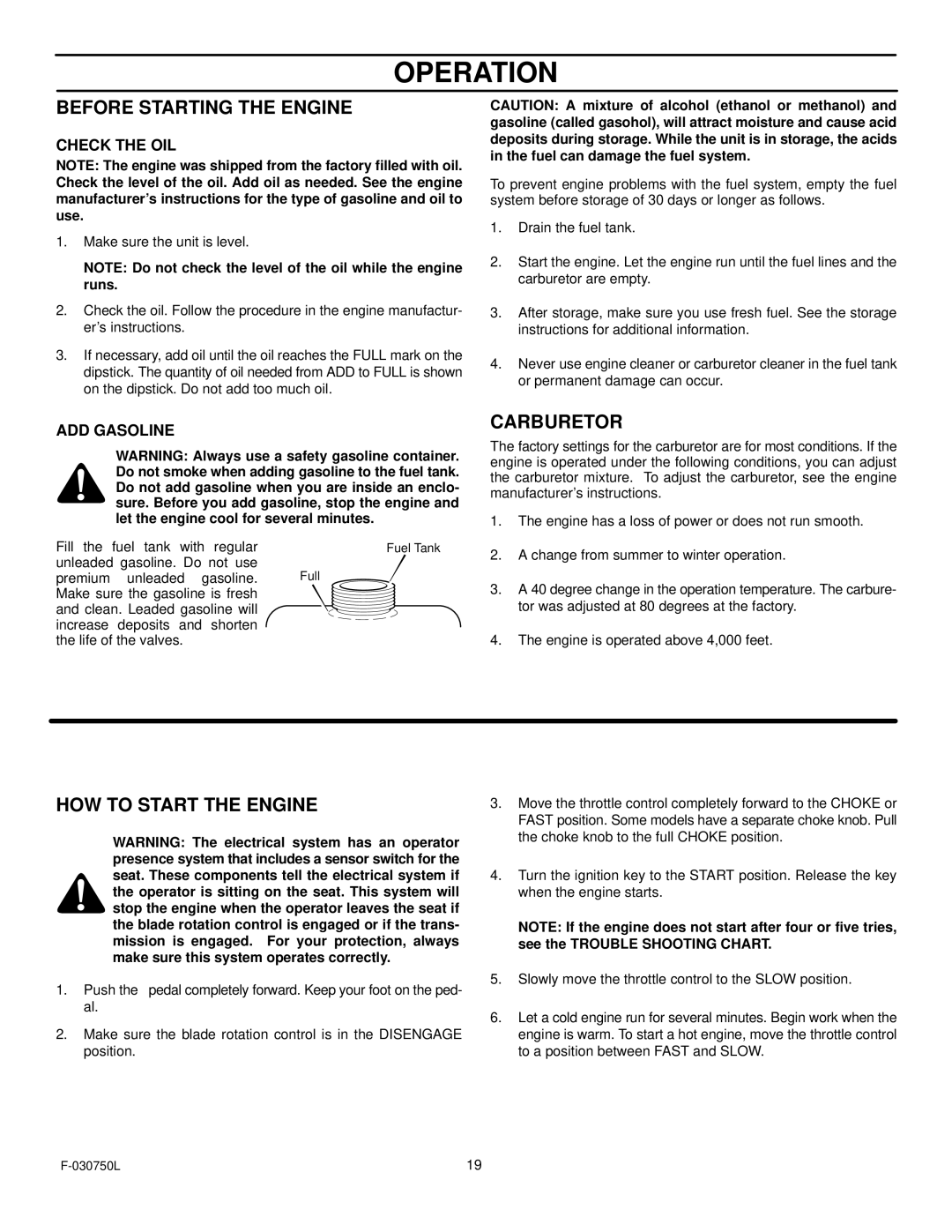
OPERATION
BEFORE STARTING THE ENGINE
CHECK THE OIL
NOTE: The engine was shipped from the factory filled with oil. Check the level of the oil. Add oil as needed. See the engine manufacturer’s instructions for the type of gasoline and oil to use.
1.Make sure the unit is level.
NOTE: Do not check the level of the oil while the engine runs.
2.Check the oil. Follow the procedure in the engine manufactur- er’s instructions.
3.If necessary, add oil until the oil reaches the FULL mark on the dipstick. The quantity of oil needed from ADD to FULL is shown on the dipstick. Do not add too much oil.
CAUTION: A mixture of alcohol (ethanol or methanol) and gasoline (called gasohol), will attract moisture and cause acid deposits during storage. While the unit is in storage, the acids in the fuel can damage the fuel system.
To prevent engine problems with the fuel system, empty the fuel system before storage of 30 days or longer as follows.
1.Drain the fuel tank.
2.Start the engine. Let the engine run until the fuel lines and the carburetor are empty.
3.After storage, make sure you use fresh fuel. See the storage instructions for additional information.
4.Never use engine cleaner or carburetor cleaner in the fuel tank or permanent damage can occur.
ADD GASOLINE
WARNING: Always use a safety gasoline container. Do not smoke when adding gasoline to the fuel tank. Do not add gasoline when you are inside an enclo- sure. Before you add gasoline, stop the engine and let the engine cool for several minutes.
Fill the | fuel tank with regular | Fuel Tank |
unleaded gasoline. Do not use | Full | |
premium | unleaded gasoline. | |
Make sure the gasoline is fresh |
| |
and clean. Leaded gasoline will |
| |
increase | deposits and shorten |
|
the life of the valves.
CARBURETOR
The factory settings for the carburetor are for most conditions. If the engine is operated under the following conditions, you can adjust the carburetor mixture. To adjust the carburetor, see the engine manufacturer’s instructions.
1.The engine has a loss of power or does not run smooth.
2.A change from summer to winter operation.
3.A 40 degree change in the operation temperature. The carbure- tor was adjusted at 80 degrees at the factory.
4.The engine is operated above 4,000 feet.
HOW TO START THE ENGINE
WARNING: The electrical system has an operator presence system that includes a sensor switch for the seat. These components tell the electrical system if the operator is sitting on the seat. This system will stop the engine when the operator leaves the seat if the blade rotation control is engaged or if the trans- mission is engaged. For your protection, always make sure this system operates correctly.
1. Push the pedal completely forward. Keep your foot on the ped- al.
2.Make sure the blade rotation control is in the DISENGAGE position.
3.Move the throttle control completely forward to the CHOKE or FAST position. Some models have a separate choke knob. Pull the choke knob to the full CHOKE position.
4.Turn the ignition key to the START position. Release the key when the engine starts.
NOTE: If the engine does not start after four or five tries, see the TROUBLE SHOOTING CHART.
5.Slowly move the throttle control to the SLOW position.
6.Let a cold engine run for several minutes. Begin work when the engine is warm. To start a hot engine, move the throttle control to a position between FAST and SLOW.
19 |
